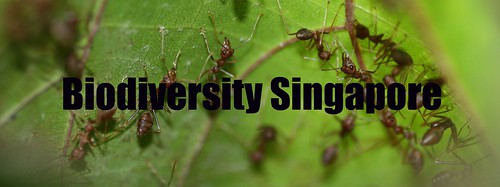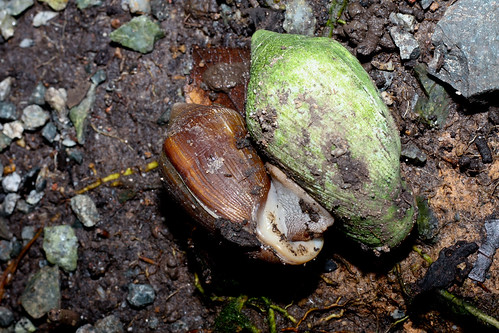Big Sister Island (Subar Laut)
Here's a closer look at the hard coral
And one that is slightly bleached.
Frilly anemone?
Let's have a look at the the Zoanthids or also known as the colonial anemones. Some Zoanthids contain toxins so DO NOT handle them with your bare hands. Toxins are to protect themselves from predators.
Can you spot the Spider Conch? Though they have spines, but they do not penetrate into your skin nor contains any venom.
Very beautiful underside, it is often collected and cause the decrease in population. They are listed as Vulnerable on the Red List of threatened animals of Singapore.
A closer look...

My 2nd encounter with an octopuses, ?the Two-spot reed octopuses?
It may look small and harmless but don't underestimate it! They have sharp beak, and can inject toxins... But they are one of the smartest creature living in this planet.
It may look small and harmless but don't underestimate it! They have sharp beak, and can inject toxins... But they are one of the smartest creature living in this planet.
Looks yummy! But this Red Egg Crab is highly toxin when eaten even after cooking. Here's a photo index to ID the crabs found in Singapore.
And the best of this trip is the hawksbill turtle! My first encounter with a hawksbill turtle! And its very close!
And off to Sungei Buloh to train our new volunteers!
From Botanic Gardens to Sungei Buloh
New volunteers from Sungei Buloh, P. Ubin & central nature reserve gather at Botanic Gardens for an orientation. The speaker is Mr Mendis Tan from Sungei Buloh. So why I'm I there? Not for the orientation but as a photographer!
Now Volunteers are known as ''conservation division volunteers'' which mean they all will fall under the conservation division. Volunteers can attend workshops not only at the reserve that they serve but can also attend workshops by other nature reserve. CooL! Allowance will be given to volunteers at Sungei Buloh ($10) and P. Ubin ($15). The $5 extra for ubin is to cover the bum boat trip. Then why CNR does not gives allowance? It's simply because it's located at the heart of Singapore and is very accessible unlike Buloh or Ubin. BUT, you should not look at the amount of allowance each place offer you and go there because this is not the right way!
After the orientation, Shila and myself rush down to Sungei Buloh to check on the Young Naturalist Passport Camp. This photo shows Shila in action! Showing the kids how to make a tailor bird nest. If you are keen to sign your kids up for the camp please visit Sungei Buloh's website.
After the camp ends, I meet up with Wei Xiang, Wei Quan and Jaime to hunt for the Estuarine Crocodile (Crocodylus porosus)! Yeh!!!! The above photo is taken from the main bridge. Estimated size of croc is about 1.8m long?
We proceed to the platform 2, WOW! Another croc waiting for us. This time round, it's smaller about 1.2m. Yeh more crocs at buloh! Note that the crocs at Buloh won't eat you up if you don't go near them because there are plenty of food down in the river.
A juvenile monitor lizard (Varanus salvator) on the tree!
Back to the main bridge, we saw the plantain squirrel (Callosciurus notatus). Very active in the day, its diet include fruits, seeds, leaves, bark and insects!
This pair of common greenback (Hylarana erythraea) is spotted at the fresh water pond.
Now Volunteers are known as ''conservation division volunteers'' which mean they all will fall under the conservation division. Volunteers can attend workshops not only at the reserve that they serve but can also attend workshops by other nature reserve. CooL! Allowance will be given to volunteers at Sungei Buloh ($10) and P. Ubin ($15). The $5 extra for ubin is to cover the bum boat trip. Then why CNR does not gives allowance? It's simply because it's located at the heart of Singapore and is very accessible unlike Buloh or Ubin. BUT, you should not look at the amount of allowance each place offer you and go there because this is not the right way!
After the orientation, Shila and myself rush down to Sungei Buloh to check on the Young Naturalist Passport Camp. This photo shows Shila in action! Showing the kids how to make a tailor bird nest. If you are keen to sign your kids up for the camp please visit Sungei Buloh's website.
After the camp ends, I meet up with Wei Xiang, Wei Quan and Jaime to hunt for the Estuarine Crocodile (Crocodylus porosus)! Yeh!!!! The above photo is taken from the main bridge. Estimated size of croc is about 1.8m long?
We proceed to the platform 2, WOW! Another croc waiting for us. This time round, it's smaller about 1.2m. Yeh more crocs at buloh! Note that the crocs at Buloh won't eat you up if you don't go near them because there are plenty of food down in the river.
A juvenile monitor lizard (Varanus salvator) on the tree!
Back to the main bridge, we saw the plantain squirrel (Callosciurus notatus). Very active in the day, its diet include fruits, seeds, leaves, bark and insects!
This pair of common greenback (Hylarana erythraea) is spotted at the fresh water pond.
Sungei Buloh - 24/06/2010
Another day out in the field with Mr KS Wong, one of our senior guides at buloh. We took a slow walk around route one to help him to take some photos for the slides that will be using for volunteer training. But in the process, i did learn a lot from him.
What's the name of this spider? Ops.... I'm no spider Xpert. But it's a jumping spider, Have a close look at its eye. When it's black in colour it mean it's looking directly at you, when it turns green that means it's looking away.
Mr Wong found millipede among the leaf litter. They will give out a pungent smell to protect itself if being disturb Here's a blog post from The annotated budak that explains more about millipedes and centipedes.

Blue Glassy Tiger (Ideopsis vulgaris macrina)
He also pointed out the Belongkeng snail. That's my first photo record! Thanks Mr Wong! Unlike some other snails, they lack of a covering call operculum which seals the opening of the shell.
And a family of 4 Smooth Otters Lutrogale perspicillata are also seen at the river along the main bridge. Otters mainly eat fishes but they do feed on crustaceans too! More Photos of otters are at my flickr.
We end our day with a Lesser Dog-faced fruit bat . They usually roost together because it's safer in numbers. They can be found roosting under palms or trees. Do you know that the flowers of the Durian trees are pollinated my bats?!
What's the name of this spider? Ops.... I'm no spider Xpert. But it's a jumping spider, Have a close look at its eye. When it's black in colour it mean it's looking directly at you, when it turns green that means it's looking away.
Mr Wong found millipede among the leaf litter. They will give out a pungent smell to protect itself if being disturb Here's a blog post from The annotated budak that explains more about millipedes and centipedes.
Common Tit (Hypolycaena erylus teatus)

Blue Glassy Tiger (Ideopsis vulgaris macrina)
He also pointed out the Belongkeng snail. That's my first photo record! Thanks Mr Wong! Unlike some other snails, they lack of a covering call operculum which seals the opening of the shell.
And a family of 4 Smooth Otters Lutrogale perspicillata are also seen at the river along the main bridge. Otters mainly eat fishes but they do feed on crustaceans too! More Photos of otters are at my flickr.
We end our day with a Lesser Dog-faced fruit bat . They usually roost together because it's safer in numbers. They can be found roosting under palms or trees. Do you know that the flowers of the Durian trees are pollinated my bats?!
Finding the Knot at Sungei Buloh
Took a short walk after guiding a group of visitors! Since it's high tide, it's a great time a have a look at the shore birds. Took a slow walk to route 2, while i was looking at the birds i saw a moving log like creature! Its a croc!
What a nice moment!
What a nice moment!
Subscribe to:
Posts (Atom)






























